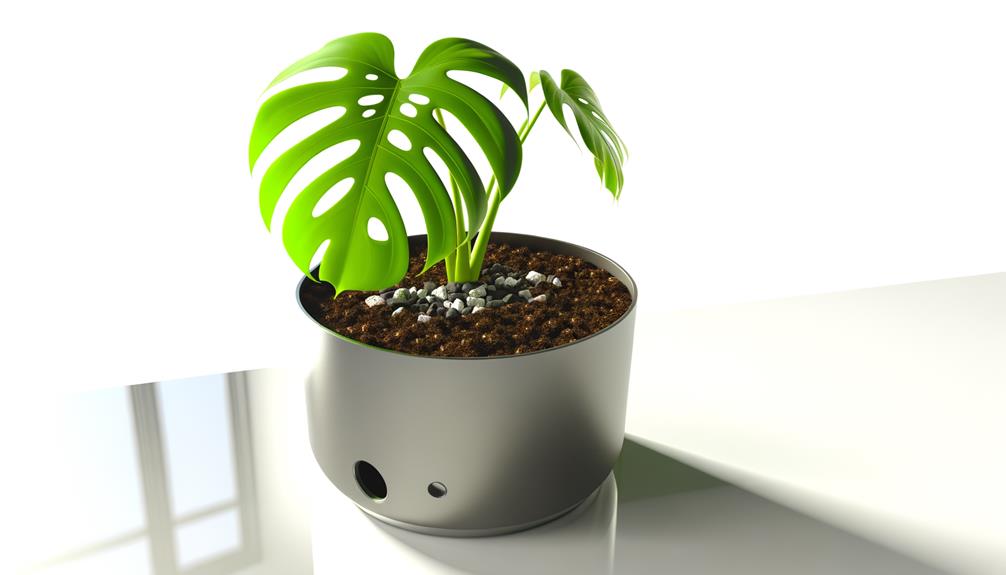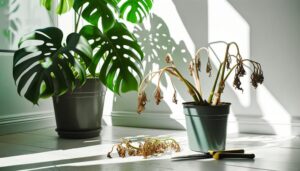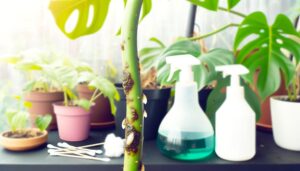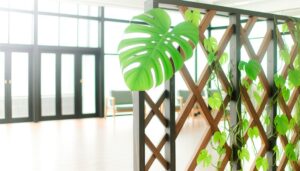Can You Pot a Monstera Deliciosa Without Drainage? Tips!
You can pot a Monstera Deliciosa without drainage, but you need to be very careful. Use a well-aerated soil mix with perlite or orchid bark to prevent compaction and stagnation.
Consistent but moderate watering is essential to avoid root rot—using a moisture meter can help. Activated charcoal can also assist in moisture regulation.
Monitor the plant’s health by looking for signs like yellowing leaves or mushy stems, which indicate issues. Regularly check for salt buildup from fertilizers, which can damage roots.
If you’re interested in optimizing your Monstera’s health further, there are additional strategies you can consider.

Key Takeaways
- Potting a Monstera Deliciosa without drainage increases the risk of root rot due to stagnant water.
- Without drainage, an anaerobic environment can foster pathogenic fungi, harming the plant.
- Soil compaction and salt buildup from fertilizers are more likely without drainage, leading to root scorch.
- Utilizing moisture-retentive but well-aerated soil components like coco coir and perlite can mitigate some risks.
- Frequent monitoring of soil moisture with a meter and adjusting watering frequency is crucial in pots without drainage.
Understanding Monstera Deliciosa Needs
To successfully pot a Monstera Deliciosa without drainage, it’s crucial to understand its specific water, light, and soil needs.
This tropical plant thrives in well-aerated soil with a slightly acidic to neutral pH, ideally between 5.5 and 7.5. You’ll need to maximize the soil’s capacity to retain moisture without becoming waterlogged. Incorporate materials like perlite or orchid bark to enhance aeration.
Monstera Deliciosa requires indirect, bright light; direct sunlight can scorch the leaves, while too little light stunts growth. Watering should be consistent but not excessive; check soil moisture levels frequently. Using a moisture meter helps in maintaining optimal conditions.
Risks of No Drainage
Potting a Monstera Deliciosa without drainage often poses significant risks, mainly due to the increased likelihood of root rot caused by stagnant water. When water accumulates at the bottom of a pot without an outlet, oxygen levels in the soil decrease, creating an anaerobic environment. This anaerobic condition promotes pathogenic fungi and bacteria that damage the roots.
Over time, the plant’s ability to absorb nutrients and water diminishes, leading to yellowing leaves and stunted growth. Additionally, soil compaction in non-draining pots exacerbates these issues by reducing aeration further. You might also encounter salt buildup from fertilizers, which can scorch roots.
Understanding these risks is essential to ensuring your Monstera thrives in a container lacking drainage.
Soil Selection Tips
When selecting soil for a Monstera Deliciosa in a pot without drainage, prioritize a well-aerated, chunky mix that retains moisture without becoming waterlogged. This minimizes the risk of root rot and promotes healthy root development.
Consider incorporating the following components:
- Orchid Bark: Enhances aeration and provides structural support.
- Perlite: Enhances drainage and prevents soil compaction.
- Activated Charcoal: Assists in moisture regulation and toxin absorption.
- Coco Coir: Retains moisture while providing good aeration.
- Compost: Supplies essential nutrients and beneficial microorganisms.
Watering Techniques
When watering a Monstera Deliciosa without drainage, you’ll want to adhere to specific frequency guidelines to prevent over-saturation. Evidence suggests that less frequent watering, allowing the topsoil to dry out, greatly reduces the risk of root rot.
Regularly monitor soil moisture using a hygrometer to maintain ideal hydration levels.
Watering Frequency Guidelines
Establishing an appropriate watering frequency for your Monstera Deliciosa without drainage requires careful monitoring of soil moisture levels and understanding the plant’s specific hydration needs.
You’ll need to maintain a delicate balance to avoid overwatering, which is critical due to the lack of drainage. Use a moisture meter or simply your finger to check the soil’s top two inches. Water the plant only when this upper layer feels dry.
Consider these guidelines:
- Frequency: Generally, water every 7-10 days.
- Volume: Provide enough water to moisten the soil without pooling.
- Humidity: Maintain high humidity levels to reduce watering frequency.
- Light: Adjust watering based on the light intensity the plant receives.
- Season: Reduce watering in winter when growth slows down.
Avoiding Root Rot
To avoid root rot while potting a Monstera Deliciosa without drainage, utilize precise watering techniques that prevent excess moisture accumulation. Opt for a moisture meter to gauge soil dampness accurately. Water only when the top 2-3 inches of soil are dry.
Employ the ‘bottom watering’ method; place the pot in a shallow tray of water and let the soil absorb moisture through capillary action. Monitor absorption time, ensuring no prolonged saturation.
Additionally, amend your potting mix with aerating components like perlite or orchid bark to enhance drainage and air circulation. Regularly check for signs of overwatering, such as yellowing leaves or mushy stems, and adjust your watering regimen accordingly. These strategies greatly reduce the risk of root rot.
Monitoring Plant Health
Regularly evaluating the plant’s leaves, stems, and roots for signs of distress or abnormal growth guarantees you detect potential issues before they become serious. This continuous monitoring is crucial to maintaining the health of a Monstera Deliciosa potted without drainage.
Look for:
- Yellowing leaves: Indicates potential nutrient deficiencies or overwatering.
- Brown leaf tips: Often a sign of inconsistent watering or low humidity.
- Soft, mushy stems: May suggest bacterial or fungal infections.
- Wilting leaves: Can result from underwatering or root damage.
- Root inspection: Check for healthy white roots; brown, mushy roots indicate severe problems.
Preventing Root Rot
One of the most important steps in preventing root rot in a Monstera Deliciosa potted without drainage is carefully managing the plant’s watering schedule. You’ll need to monitor soil moisture levels meticulously. Use a moisture meter to check the soil before watering, ensuring it’s dry at least 2 inches down. This prevents waterlogged conditions that can lead to root rot.
To further reduce risk, incorporate materials that enhance aeration and water retention balance, such as perlite or orchid bark.
| Material | Function | Benefit |
|---|---|---|
| Perlite | Improves aeration | Reduces water retention |
| Orchid Bark | Enhances drainage | Prevents over-saturation |
| Activated Charcoal | Absorbs toxins | Keeps soil fresh |
Choosing the Right Pot
Selecting a suitable pot for your Monstera Deliciosa is essential to maintaining ideal soil conditions and preventing root rot.
When choosing a pot without drainage, consider the following factors:
- Material: Opt for porous materials like terracotta to aid in moisture regulation.
- Size: Ensure the pot is 2-4 inches larger in diameter than the root ball to allow growth.
- Depth: Depth should facilitate sufficient root expansion without waterlogging.
- Shape: A wider base can help distribute moisture more evenly.
- Weight: Heavier pots provide stability, especially for larger monstera plants.
These considerations help maintain an optimal balance of moisture and aeration, vital for a healthy Monstera Deliciosa.
Proper pot selection directly influences soil health and plant vitality, minimizing the risk of root diseases.
Alternative Drainage Solutions
To successfully pot a Monstera Deliciosa without traditional drainage, consider integrating alternative drainage solutions like adding a layer of activated charcoal or perlite at the bottom of the pot to enhance aeration and prevent water stagnation.
Activated charcoal absorbs excess moisture and neutralizes toxins, reducing the risk of root rot. Perlite, a volcanic glass, improves soil aeration and facilitates better water distribution.
You might also want to use a soil mix with a high proportion of coarse materials, such as bark chips or pumice, to further promote drainage. Regularly monitoring soil moisture levels with a moisture meter ensures optimal water management.
These methods create a well-balanced environment, mitigating the risks associated with pots lacking drainage holes.
Conclusion
While you can pot a Monstera deliciosa without drainage, it’s important to understand the risks and take preventive measures. Did you know that over 90% of houseplant root rot cases stem from poor drainage?
By choosing well-aerated soil, watering sparingly, and monitoring plant health, you can reduce these risks. Opt for pots with alternative drainage solutions like a layer of gravel or perlite to guarantee your Monstera thrives.
Use evidence-based practices to maintain strong plant health and prevent root rot.






